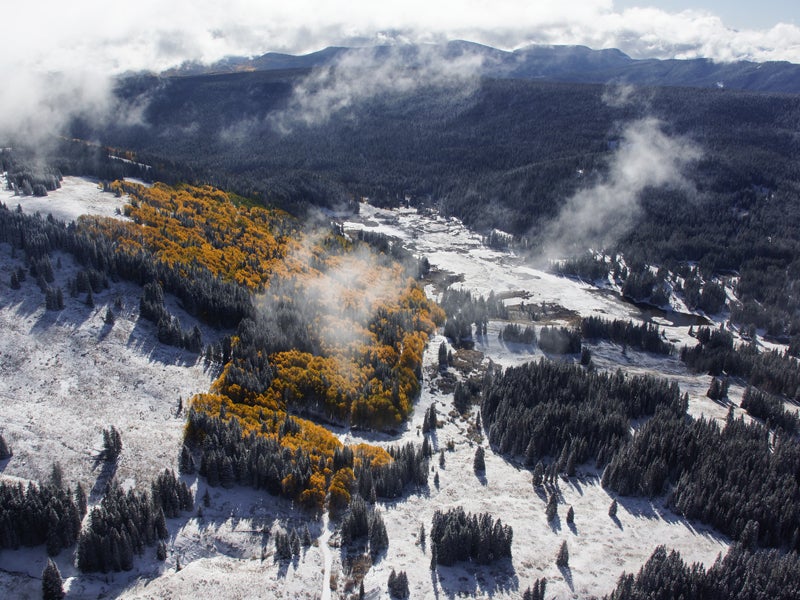Cold Winds Rise: Five Frozen Treasures Under Threat
These majestic winter landscapes could be targeted by the next presidential administration.

This page was published 9 years ago. Find the latest on Earthjustice’s work.
With the onset of winter, cold winds will shroud landscapes beneath a blanket of snow and glittering ice. These vistas are awe-inspiring, and recent political threats to America’s wild lands make the fight to protect them even more pressing.
America’s public lands face many challenges, including President-elect Trump’s rhetoric sometimes encouraging the privatization and exploitation of public lands. But there is strong public support for keeping public lands, well, public. Earthjustice will be resisting any efforts to open these irreplaceable lands to more development:
Tahoe National Forest, California
Scouring glaciers shaped this area in the Sierra Nevada Mountains more than a million years ago. Rivers, snow-capped peaks and dense forests contain a complex set of ecosystems that range from 1,500 to 9,000 feet above sea level. Massive old-growth trees provide refuge for 570 vertebrate wildlife species and hundreds of invertebrate species, some of which can’t be found anywhere else on the planet.
This forest has been under attack for decades, and 2016 was no exception. In 2012, a coalition of off-road vehicle groups challenged a U.S. Forest Service plan that restricts the use of motorized vehicles in the national forest. Earthjustice intervened, and in February of this year the Ninth Circuit Court of Appeals upheld the plan, allowing Tahoe National Forest to retain its protections against environmentally damaging off-road vehicles.
Tongass National Forest, Alaska
The Tongass, located in southeast Alaska, is America’s largest national forest. It’s filled with centuries-old trees, ice fields and glaciers, as well as fast-flowing rivers, fjords and thousands of islands. Earthjustice has been working since its inception to protect this old-growth forest from unsustainable logging.
This year, the state of Alaska—egged on by the regional timber industry—made a last-ditch effort to exempt the Tongass from the Roadless Area Conservation Rule, a national rule that protects undeveloped national forests from logging and road construction. In March, capping a hard-fought Earthjustice victory for the old-growth forest, the U.S. Supreme Court declined to hear Alaska’s appeal.
The Arctic
Here, cold is a way of life and creatures thrive amid the ice and snow. Seals, walruses, polar bears and bowhead whales have made their home in these frigid climes, as have vibrant Alaska Native communities that have depended on the ocean for millennia. Today, the Arctic climate is warming at twice the rate of the rest of the world, putting tremendous strain on its wildlife and people.
This November, the Obama administration announced it will exclude the Arctic Ocean from a federal oil and gas leasing program for the next five years. Earthjustice has fought for years to protect the Arctic from oil and gas development, and this decision was a milestone.
Idaho Panhandle National Forests and Kootenai National Forest, Montana and Idaho
More than a century ago, silver, gold and timber enticed settlers to these forests. Despite decades of timber exploitation, these national forests remain home to rugged and wild lands that provide habitat for wolves, grizzly bears, bull trout and the last population of woodland caribou in the lower 48 states. These rare expanses of unspoiled land are prized by outdoor enthusiasts for their beauty, peace and solitude.
Earthjustice has been fighting to protect these wild areas from the damaging effects of snowmobiles and four-wheelers. In 2015, the U.S. Forest Service issued revised forest management plans that prohibit snowmobiles and other motorized use in certain rugged and unspoiled areas in these forests. Not long after the plans came into effect, snowmobilers filed a lawsuit to overturn them. Earthjustice represents a coalition of conservation groups and non-motorized winter recreationalists intervening in the lawsuit to defend the last pockets of wilderness-quality land in these otherwise heavily logged and motorized forests.
The Thompson Divide and White River National Forest, Colorado
The Thompson Divide spans more than 200,000 acres near Carbondale, Colorado, much of which is pristine roadless forest. The Thompson Divide and nearby roadless lands in the White River National Forest provide crucial habitat for wildlife and threatened plant species, and they are also an important economic driver that supports recreation companies and provides ranchers with grazing land for their livestock.
These unspoiled forests lie in the path of oil and gas development, and Earthjustice has fought for years to keep it at bay. This November, in a victory for the treasured area, the federal government finalized a plan that cancels 25 oil and gas leases in the Thompson Divide and protects 33,000 acres of land there. However, the plan left out other important areas that were under consideration, so Earthjustice will keep pressing to safeguard them.